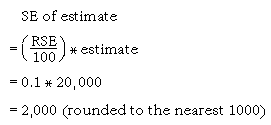TECHNICAL NOTE: SAMPLING VARIABILITY
INTRODUCTION
1 The estimates in Pregnancy and Employment Transitions, Australia (cat. no. 4913.0) are based on information obtained from the occupants of a sample of dwellings. Therefore the estimates are subject to sampling variability and may differ from those estimates that would have been produced if all dwellings had been included in the survey. One measure of the likely difference is given by the standard error (SE), which indicates the extent to which an estimate might have varied by chance because only a sample of dwellings was included. There are about two chances in three (67%) that a sample estimate will differ by less than one SE from the number that would have been obtained if all dwellings had been included, and about 19 chances in 20 (95%) that the difference will be less than two SEs. Another measure of the likely difference is the relative standard error (RSE), which is obtained by expressing the SE as a percentage of the estimate.
2 In general, the size of the SE increases as the size of the estimate increases. Conversely, the RSE decreases as the size of the estimate increases. Very small estimates are subject to such high RSEs that they are considered unreliable for most practical purposes. In the tables in this publication, only estimates with an RSE of less than 25% are considered reliable for most purposes. Estimates with an RSE ranging from 25% to 50% are preceded by an asterisk (e.g. *3) to indicate they are subject to high SEs and should be used with caution. Estimates with RSEs of greater than 50%, preceded by a double asterisk (e.g. **1), are considered too unreliable for general use and should only be used to aggregate with other estimates to provide derived estimates with RSEs of less than 25%.
CALCULATION OF STANDARD ERROR AND RELATIVE STANDARD ERROR
3 Each table of estimates in this publication has an associated table of RSEs. The RSEs have been derived using the group jackknife method.
4 SEs can be calculated using the estimates (counts or means) and the corresponding RSEs. For example, Table 4 shows that the estimated number of employed women with a youngest natural child aged 0 to 3 months is 20,000. In the corresponding RSE table, the RSE for this estimate is shown to be 10%. The SE is:

5 Therefore, there are about two chances in three that the value that would have been produced if all dwellings had been included in the survey will fall within the range 18,000 to 22,000 and about 19 chances in 20 that the value will fall within the range 16,000 to 24,000. This example is illustrated in the diagram below.
Proportions and percentages
6 Proportions and percentages formed from the ratio of two estimates are also subject to sampling errors. The size of the error depends on the accuracy of both the numerator and the denominator. A formula to approximate the RSE of a proportion is given below. The formula is only valid when x is a subset of y.

7 As an example, using estimates from Table 4, of the 52,000 employed women with a youngest natural child aged 7 to 12 months, 7,000 or 13% were on leave for the birth. The RSE for 7,000 is 23% and the RSE for 52,000 is 8% (as shown in the corresponding RSE table). Applying the above formula, the RSE for the proportion of employed women with a youngest natural child aged 7 to 12 months who were on leave for the birth is:

8 Therefore, the SE for the proportion of employed women with a youngest natural child aged 7 to 12 months who were on leave for the birth is 3 percentage points (=(22/100) x 13). Therefore, there are about two chances in three that the proportion of employed women with a youngest natural child aged 7 to 12 months who were on leave for the birth is between 10% and 16%, and 19 chances in 20 that the proportion is within the range 7% to 19%.
Sum or Differences between estimates
9 Published estimates may also be used to calculate the sum of, or difference between, two survey estimates (of numbers, means or percentages). Such estimates are also subject to sampling error.
10 The sampling error of the difference between two estimates depends on their SEs and the relationship (correlation) between them. An approximate SE of the difference between two estimates (x - y) may be calculated by the following formula:

11 The sampling error of the sum of two estimates is calculated in a similar way. An approximate SE of the sum of two estimates (x + y) may be calculated by the following formula:

12 As an example, from paragraph 4 the estimated number of employed women with a youngest natural child aged 0 to 3 months is 20,000 and the SE is 2,000. From Table 4, the estimate of employed women with a youngest natural child aged 4 to 6 months is 20,000 and the SE is 3,000. The estimate of employed women with a youngest natural child aged 0 to 6 months is:

13 The SE of the estimate of employed women with a youngest natural child aged 0 to 6 months is:

14 Therefore, there are about two chances in three that the value that would have been produced if all dwellings had been included in the survey will fall within the range 36,000 to 44,000 and about 19 chances in 20 that the value will fall within the range 32,000 to 48,000.
15 While these formulae will only be exact for sums of, or differences between, separate and uncorrelated characteristics or subpopulations, it is expected to provide a good approximation for all sums or differences likely to be of interest in this publication.
 Print Page
Print Page
 Print All
Print All